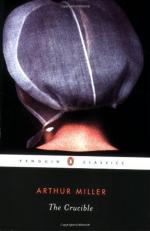|
This section contains 963 words (approx. 4 pages at 300 words per page) |

|
Changing Moral Levels in "The Crucible"
Summary: In Arthur Miller's "The Crucible," the level of morality of the characters can be explained by Lawrence Kohlberg's system for determining the moral level of ethical decisions and actions. For example, Abigail Williams is the most-dangerous villian in the novel, and her selfish likes and lusts places her at Kohlberg's stage 0: egocentric judgment.
In Salem, everything is based on whether you're with God or the Devil. Anyone whose life doesn't conform to the established moral laws was considered a threat to society and disobeying the rule of God. In Act II, Danforth says "a person is either with this court or he must be counted against it." By this they felt hanging all the witches (or those under the Devil's worship) would restore the purity of the community. Lawrence Kohlberg created a number system to show the moral levels of the ethical decisions and actions of the characters. Each level explains the rank of moral development and the character's response and beliefs. Throughout the book, many of the characters moral levels change and as the book is titled The Crucible (meaning a harsh moral test), there are definitely characters who passed, and many who did not.
Although Abigail Williams is seen...
|
This section contains 963 words (approx. 4 pages at 300 words per page) |

|


